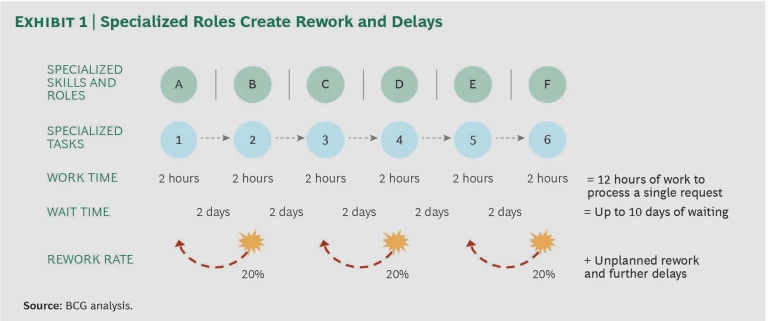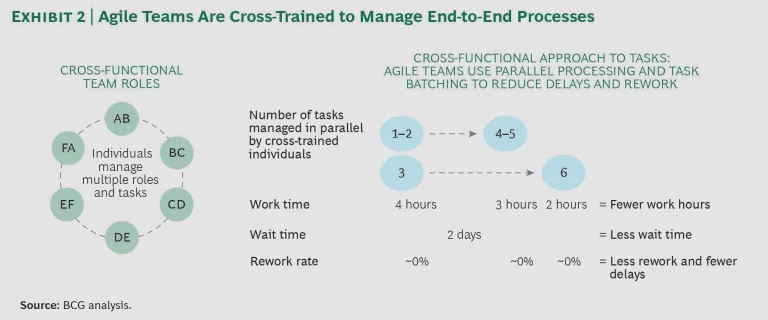For most companies, agile is confined to software development—but it doesn’t need to be. Increasingly, forward-thinking companies are taking advantage of the same agile techniques that have transformed software development. Now they are successfully deploying these techniques in other core business units, from marketing to human resources to finance. When companies implement agile across their entire organizations, ways of working improve dramatically. Agile methods are more collaborative and creative and can be more efficient than other business models. But companies must first understand why their current business structures need to change.
The Downside of Traditional, Specialized Roles
Most large, hierarchical organizations are structured around silos and specialized functions. It’s not uncommon to see companies organized in such a way that a single customer need (such as processing an order) requires action from more than ten distinct units. But this model introduces a number of inefficiencies:
- Queuing Delays. Handoffs from one specialized employee to another create internal queues; each order or task slowly churns through the system in a linear fashion, delaying the speed of end-to-end customer service.
- Rework. Each time there’s a handoff from one specialized worker to another, the chance that rework will be required increases because individual employees responsible for a single isolated task have little understanding of how their work fits into the larger whole. This rework culture can be especially problematic in complex environments where errors in the details can create big problems later in the process.
- Lack of Ownership. When individuals are assigned only discrete tasks, no one is ultimately responsible for the customer outcome. This generates frustration for customers because finding the right person to fix a given problem may be nearly impossible.
Companies that rely on overly specialized roles create meaningful inefficiencies that can damage the customer experience. (See Exhibit 1.) Customers forced to endure delays owing to multiple handoffs or rework will soon take their business elsewhere. Yet many large companies find restructuring difficult because their organizations are bogged down by a large and highly customized product catalog, disparate IT systems, or poorly integrated M&A activity—all of which bolster the need for specialized resources. While displacing deeply entrenched processes and practices can be difficult, companies that successfully incorporate agile beyond software see transformative results.
Getting Started
To implement agile across an entire business, teams need to work together differently than in the past. Siloed employees no longer perform discrete, predefined tasks in isolation. Instead, cross-disciplinary, collocated teams collaborate in innovative ways to enhance the customer experience. By working iteratively and incorporating feedback to continually improve, agile teams across all functions have the potential to transform the business from the inside out. To capitalize on the many benefits of agile, companies need to take four key actions.
Create cross-functional teams. To get started, organizations should create cross-functional teams of approximately five to ten employees each—small enough to collaborate closely but large enough to possess the necessary skills to execute successfully. These agile teams perform a given process from beginning to end, batching tasks to increase productivity and parallel processing to maintain forward momentum. Individual employees handle multiple steps to reduce overall work time and avoid the delays that come from excessive context switching. With brief, regular interactions, the teams resolve questions quickly rather than throwing issues back over the wall.
Because many companies are still organized around highly specialized functions, however, the shift toward agile often requires consolidation—from large numbers of specialists to small teams of cross-trained individuals. In a cross-functional team, for example, one employee may tackle tasks A and B, which were previously handled by two employees. (See Exhibit 2.) Over time, as employees undergo additional cross-training, roles can be further consolidated. Of course, role consolidation has its limits. In some areas, specific expertise is required (in the case of a lawyer or specialized engineer, for example). But these specialists should work with cross-functional teams to support customers. By reorganizing into these more productive teams, organizations can dramatically reduce the number of employees necessary to fulfill a request, eliminate inefficient handoffs, and improve visibility into their customers’ needs.
Recently, an international telecom company transitioned to cross-functional teams in its enterprise order-processing function to help improve customer satisfaction while reducing costs. Historically, the company had routed customers through 12 specialized groups, each dedicated to a discrete task, but this process led to costly delays and frustrated customers. And to make matters worse, the specialized groups were located in different parts of the world, which only exacerbated delays and rework. Instead, the organization created small agile operations teams responsible for end-to-end customer service. Each operations team comprised three smaller groups: order administrators, technical staff, and billing and customer service personnel.
These teams were not just an oversight layer. They performed the full scope of work—including ordering, provisioning, billing, and support—that previously had been fragmented across the organization. By holding the teams accountable for outcomes, the company gave them strong incentives to reduce complexity, eliminate handoffs and rework cycles, and continually streamline the customer experience.
Cultivate servant-leaders to drive value. As teams shift their focus toward the overall customer experience, leadership styles need to shift as well. Leaders should no longer assess individuals on their ability to complete tasks but on their effectiveness in delivering end-to-end outcomes for customers. (See the sidebar.) To support this new structure, companies would do well to cultivate servant-leaders—that is, leaders who focus first and foremost on helping their employees perform optimally and collaborate effectively. The goal of these leaders should be to foster a motivated and empowered workforce and to help remove impediments to rapid progress. They may set a direction, but they don’t delegate or micromanage day-to-day decisions.
A European Bank Delivers Agile End-To-End Solutions
A European financial services company created a new organizational model, inspired by Zappos, that empowered small, autonomous units to deliver end-to-end solutions for all nondigital customer service requests, particularly phone calls.
Instead of optimizing the call center and customer service operations for scale and efficiency (with a focus on average handling time, for example), the bank focused on enhancing customer satisfaction. It created customer loyalty teams (CLTs)—autonomous, multidisciplinary, collocated teams of 10 to 12 members—and gave them a mandate to resolve issues on the spot.
CLT members were assigned broad roles so that they could switch between answering customer calls and handling operational tasks. The company empowered them to self-schedule availability as a team and closely track output metrics related to customer satisfaction. Traditional manager responsibilities were redistributed to CLT leads, agile coaches, and the team as a whole. To support the new way of working, the bank also addressed talent development in areas such as recruiting, training, and performance management.
As a result, the company improved its net promoter scores, reduced handovers and repeat call volume to achieve 25% efficiency gains, and significantly boosted employee engagement.
Adopt—and tailor—standard agile methods. One of the most valuable benefits of agile is that it encourages teams to iterate quickly, learn from feedback, and shift course as needed, rather than adhering to a strict plan. The following agile methods, among others, can be used to reinforce the right behaviors and maintain strong forward momentum:
- Agile ceremonies—such as standups (daily meetings), sprints (brief work efforts designed to deliver a minimum viable product), and retrospectives (reflections on prior sprints)—allow teams to identify critical customer needs, brainstorm solutions to challenges, and target areas for improvement. By tracking processes all the way through to the customer outcome, organizations can enhance operations at all stages—from R&D to launch to customer care.
- Agile backlogs and dashboards can be used to organize work and track progress, enabling teams to prioritize tasks, eliminate bottlenecks, and identify automation opportunities.
- Agile techniques, such as A/B testing and a test-and-learn approach, encourage teams to analyze user data and focus their priorities accordingly.
Many best-in-class marketing organizations have begun to use agile techniques to expedite the development of new initiatives. (See The Agile Marketing Organization, BCG Focus, October 2015.) For example, some leading organizations appoint a scrum master, who leads rapid sprints to develop integrated marketing initiatives, apps, and websites. Each day, the team holds a 15-minute standup, in which members brainstorm ways to unblock activities and keep one another on track. Along the way, team members test and learn from experiments and, finally, determine what they can accomplish in the next sprint. These techniques can dramatically accelerate the pace at which marketing organizations innovate—and teams have much greater awareness of their overall impact on the business and its customers. While agile ceremonies alone won’t make an organization agile, they can certainly encourage the right behaviors on a daily basis.
Automate relentlessly. While all the actions outlined thus far can improve the customer experience, they won’t necessarily lower costs. To do that, teams need to find ways, where possible, to automate the end-to-end process. Every time team members must perform a high-frequency manual task, they should explore options for automating the process to eliminate inefficiencies. Agile teams can also analyze the ways in which customers use various digital channels and develop self-service options to streamline interactions. Automation not only reduces the overall volume of work that needs to be completed, it allows teams to become more productive, freeing up capacity for more innovative endeavors.
The international telco described earlier created a group focused exclusively on automation. By dedicating a team to automation, the company identified obstacles that slowed cycle times and discovered numerous opportunities to automate processes, enhance systems, simplify products, and introduce self-service tools.
In the digital era, every aspect of business needs to move faster than ever before. Companies need to accelerate implementation of initiatives, eliminate costly delays, and continually improve the customer experience. Agile has a proven track record in all these crucial areas. By taking agile way beyond software, organizations have the opportunity to enhance their understanding of customers’ needs. As a result, they not only reduce the complexity of internal operations but also create powerful opportunities to win customer loyalty and significantly outperform their peers in the marketplace.








